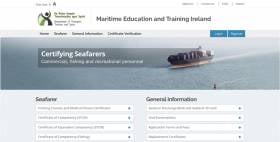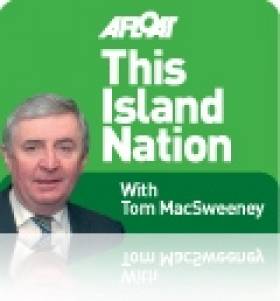Displaying items by tag: seafarers
Transport Launches New ‘Seafarers’ Website
#Seafarers - The Department of Transport, Tourism and Sport (DTTAS) has launched its new Seafarers web resource for all seafarers, fishers, recreational craft users and others looking to obtain certification or qualification in the sector.
The new website is intended as a national and international resource for information relating to seafarers, which includes those involved in commercial shipping, the fishing industry and the recreational craft sector.
It provides full details of the career structures available and how to obtain the necessary qualifications for work in the industry, as well as for recreational craft users.
The site hosts all appropriate application forms and also provides for the verification of qualifications, listing details of approved training course providers in Ireland.
DTTAS says the Seafarers website forms part of a wider updating of seafarer education and training in Ireland, and is supported by a new Seafarers Information System, which provides for the registration of all seafarers and for life-long training and career development.
The department encourages seafarers who already hold Certificates of Competency or radio certificates issued in Ireland to register now on the new information system.
Dublin Port Invests €0.5m in New Seafarers’ Centre
Dublin Port Company has opened a new state-of-the-art Seafarers’ Centre at Dublin Port following a €500,000 investment in the facility. The new Seafarers’ Centre was unveiled today at an official opening attended by guest of honour, the Lord Mayor of Dublin Mayor Críona Ní Dhálaigh, who is also Honorary Admiral of Dublin Port.
The Seafarers’ Centre breathes new life into the site of the old Odlums flour mill. Housed in the former Odlums workers’ canteen, which had been in use up to the mill’s closure in 2012, the Centre now provides a base for vital services to sailors docking in the port, an essential workforce of the city’s economy. Features of the old canteen building such as decking, beams and the original exterior wall have been retained and preserved as part of the new design.
As Dublin Port’s first custom-built Seafarers’ Centre, it will support over 7,500 visiting seafarers a year arriving from all over the world, typically from countries such as India, China, Ukraine, Russia and the Philippines.
In addition to Dublin Port’s €500,000 investment, the International Transport Workers’ Federation has committed €55,000 in funding towards the completion of the Centre, helping to support its role in representing the best interests of transport workers globally.
Features of Dublin Port’s purpose-built Seafarers’ Centre include free Wi-Fi access for sailors to contact family and loved ones while ashore, cooking and dining facilities, and a relaxation and recreation space including a pool table, library and TV den with beanbags.
The new Centre also brings together two long-standing traditions in caring for seafarers in Dublin, the Anglican Mission to Seafarers (The Flying Angel) and the Catholic Apostleship of the Sea (Stella Maris). Both organisations will operate together under one roof at Dublin Port to provide spiritual guidance and friendship to seafarers of all faiths, and those of none. The Flying Angel will relocate to the Seafarers’ Centre from its existing location, while Stella Maris’ presence at the Centre will complement the organisation’s existing operation at its city centre location on Beresford Place.
Ardmhéara Críona Ní Dhálaigh said at the official opening; “I mo cháil oifigiúil mar Ardmhéara agus Aimiréil Oinigh Chalafort Bhaile Átha Cliath, tá an-áthas orm an t-Ionad Mairnéalaigh nua seo a oscailt.
I commend Dublin Port for creating such a welcoming facility for the thousands of seafarers who visit our shores and make a valuable contribution to our city and society. It’s wonderful to see the Catholic Apostleship of the Sea and the Anglican Mission to Seafarers working in tandem to continue their respective traditions of caring for seafarers, and providing these workers with a home from home.”
Chief Executive of Dublin Port Company Eamonn O’Reilly said; “We are delighted to open Dublin Port’s new purpose-built Seafarers’ Centre. It means that Dublin Port can provide sailors working thousands of miles from home with a space to rest, socialise and connect with family and friends under the care of Stella Maris and the Flying Angel. The Centre is a fine example of sustainable development in practice at Dublin Port. Odlums is an iconic part of Dublin Port’s industrial heritage, and that makes today’s opening particularly special.”
Tall Ships, Galway Volvo Ocean Race, European Tour, Sharks and More
An unforgettable experience on a tall ship, Galway and the Volvo Race, the MOD70 European Tour in Dublin, protection for seafarers after 92 years, Wi-Fi and sharks, topics in your TIN this week.
Read on ....
UNFORGETTABLE EXPERIENCE" ON A TALL SHIP
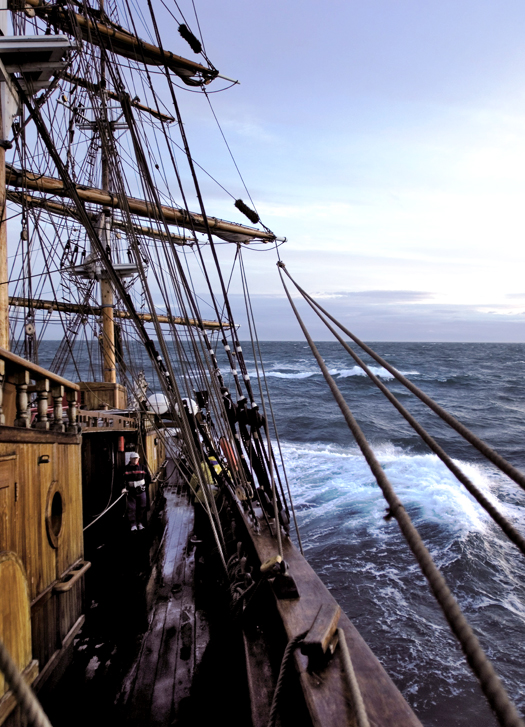
Sailing the Jeanie Johnston
With the Tall Ships Race in Dublin, Captain Michael Coleman has answered my question as to what it is like to command one of these vessels:
"Sailing in good weather on a clear and starry night is an unforgettable experience. The distractions of the land are left far behind and you become at one with nature and the elements."
Captain Coleman of Cobh sailed the Jeanie Johnston in the 2005 Tall Ships Race out of Waterford. "An unforgettable experience never to be repeated," he says and he is right, because at the start of that race Ireland had three tall ships and they led the fleet down the Waterford Estuary to the sea – Asgard, Dunbrody and Jeanie Johnston.
"The distractions of the land are left behind and you become at one with nature and the elements," aboard a tall ship says Capt. Coleman. "No TV or mobile phones or the pressure of modern living, just the ship, the wind and the sea and yourself."
His description is in a new book about the tall ship from Kerry, published by Collins Press of Cork to mark the Tall Ships Race in Dublin. Michael English, who was born in Liverpool and studied art in Cork, then worked in advertising in Dublin, made a photographic record of his voyage aboard the Jeanie Johnston in 2005. This forms the new book: 'Jeanie Johnston – Sailing the Irish Famine Tall Ship.'
The Jeanie Johnston has been berthed for some years as a floating museum on the Liffey in Dublin. As tall ships from around the world gather this week in the capital, while there will be smaller Irish vessels taking part, this island nation does not have an active, sailing tall ship providing training for Irish young people.
VOLVO RACE AND GALWAY
Will we see another race village in Galway again?
Applications from ports around the world to stage the next Volvo Race must be lodged with Volvo by next month and the 'Let's Do It Global' group which ran the event in Galway is not, so far, preparing one it seems, despite the great success of twice staging the event there, this year and in 2009.
Raising the money needed is the problem.
900,000 people attended the race festival in Galway this year, the organisers said and there was a major economic spin-off for the city. A study of the 2009 stopover estimated the economic impact at €55.8 million with more than 650,000 visitors.
The €4 million fee for hosting this year's event was paid directly to the Volvo Ocean Race organisation as the price for bringing it to Galway by Fáilte Ireland. The Galway organisers found it difficult to secure sponsorship in the current economic climate. Galway Harbour Company, which closed the port for the nine-day festival and Galway City Council were major backers. The event had huge voluntary effort. A number of State agencies hosted events and provided logistical support.
Galway Chamber of Commerce called on the Government to provide the necessary support to secure a third successful bid for Galway.
John Killeen one of the leading forces in getting the race to Galway has said the event would have to be underwritten by a bigger entity than just a voluntary group.
As a host port in this year's event, Galway received an automatic invitation for inclusion in the next race in 2014/2015, with the final decision on port selection to be made by the race organisers in December.
EUROPEAN TOUR FOR IRELAND
The MOD70 is coming to Ireland
Ireland continues to gain a reputation as one of the best sailing locations in the world. The new global sailing championship series, the MOD70 European Tour will be in Dun Laoghaire from Wednesday, September 5 to Sunday, September 9, hosted by the National Yacht Club and Dun Laoghaire Harbour Company. Many of the world's top sailing events have been held in Ireland this year.
The high speed MOD70 class of trimarans are a new innovation in sailing. Each MOD70 is identical, built from the same moulds. That should reflect the skills of the sailing crew in performance and not technological advantage.
The MOD70s coming to Dublin Bay will be - Race For Water, FONCIA, Groupe Edmond de Rothschild, Spindrift Racing and Musandam Oman Sail.
On Friday, September 7 and Saturday, September 8, they will sail the Dublin City Race and Speed Match Races. The trimarans will leave Dun Laoghaire at 3 p.m. on Sunday, September 9, for the start of the second leg of the European Tour from Dun Laoghaire to Cascais.
AFTER 92 YEARS – SEAFARERS TO GET WORK PROTECTION
The labour rights of the world's 1.2 million seafarers are to be protected in a new charter – the Maritime Labour Convention. Following its ratification by 30 countries it will go into effect in a year's time – ninety-two years after it was first proposed.
The International Labour Organisation is the United Nations' agency for internationally-recognised labour rights. The Convention was adopted back in 2006 but could not be put into effect until 30 countries adopted it. They represent nearly 60 per cent of the world's shipping tonnage, meaning that seafarers working on more than 50 per cent of the world's international shipping will be covered by the new Convention. Ireland is a member of the ILO but has not yet signed the Convention.
• A safe and secure workplace that complies with safety standards
• Fair terms of employment
• Decent working and living conditions on board ship
• Health protection, medical care, welfare measures and other forms of social protection
TRACKING WHITE SHARKS
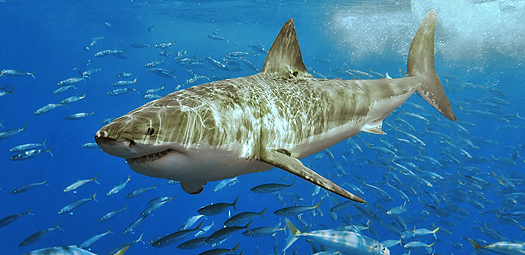
Marine researchers are using "ocean WiFi hotspots" in their latest attempts to track the movements of white sharks. The species is under threat. Sharks take several years to reach maturity and spawn. An unmanned 'Wave Glider' robot is the latest development in ocean technology. It has been deployed near San Francisco in US waters. The self-propelled solar-powered glider is part of a new network including data receivers on fixed buoys that will pick up signals from acoustic tags on animals passing within 1,000 feet and transmit the data to a research team on-shore at Stanford University Marine Sciences Department. These are the result of 12 years development of fixed and mobile ocean transmitters to follow thousands of species. They increase scientific capacity to observe the oceans and marine populations, improve fisheries management models and monitor animal responses to climate change.
• The tracking can be followed in real time on a smartphone and tablet computer app "Shark Net" available free of charge at the Apple app store.
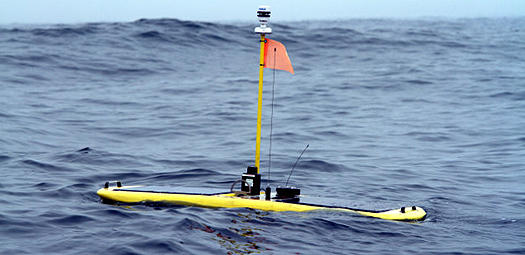
White shark tracking robot
FIRST USA WAVE POWER PLANT
Approval has been given for the building of the first commercial wave-power plant in the USA. The Federal Energy Regulatory Commission has issued a 35-year licence to Ocean Power Technologies Inc. to build the plant, intended to produce 1.5-megawatts of power, 2.5 miles off the coast of Reedsport, Oregon.
--------------------------------------------------------------------------------------------------------
• Email your maritime comments to TIN: [email protected]
Follow me for more maritime news and comment on Twitter: @TomMacSweeney
• And on Facebook – THIS ISLAND NATION page:
Marine Notice on Changes to Lifeboat Release Mechanisms
#NEWS UPDATE - A recent Marine Notice from the Department of Transport, Tourism and Sport (DTTAS) advises on the adoption of new international resolutions pertaining to SOLAS regulations and changes to the International Life-Saving Appliance (LSA) Code.
The changes are intended to establish new stricter safety standards for lifeboat release and retrieval systems, aimed at preventing accidents during lifeboat launching, and will require the assessment and possible replacement of a large number of lifeboat release hooks.
Both of these changes are expected to come into force from 1 January 2013 with a view to full compliance by July 2019.
The Maritime Safety Committee of the International Maritime Organisation has also approved new guidelines for the evaulation and replaceent of lifeboat release systems, in which the DTTAS will require fall preventer devises, or FPDs, to be fitted.
Complete details for shipowners, ship operations, shipmasters and seafarers are included in Marine Notice No 54 of 2011, a PDF of which is available to read and download HERE.
Remembering Seafarers Who Saved the Nation
City Quay in the centre of Dublin can be a cold place when the wind whips upriver from the open sea.
There was a 'bite' in the wind as I stood there in late November last year, recording the sounds of remembrance. Men, women and children stood in front of a monument where, on most days, traffic pours past and the great majority of people in those vehicles may not realise they are passing a hallowed spot which remembers men without whom this nation would have ground to a halt. This nation may be in a state of "economic war" at present, it was in a real state of war when those men died.
Every year, on the second last Sunday of November, this gathering takes place, when the men of the Irish mercantile marine who lost their lives at sea during the Second World War are remembered. Mass is celebrated in the City Quay Parish Church. Then there is a short walk to the Seamen's Memorial where wreaths are laid. That is followed by tea, coffee and a chat in the parish hall where it is a time of memories for former seafarers and their families. Friendships are renewed as the "family of the sea" gathers. In the afternoon, there is another Memorial Service St. Patrick's Cathedral.
These are poignant occasions which, in recent years, have been extended to embrace, remember and honour all Irish seafarers who have died at sea. The Maritime Institute of Ireland organises the event. Its Cork Branch also holds a remembrance service in November.
The month of November is an important one in the history of Irish maritime affairs.
It was on November 14, 1984 that the then Irish Government, a Fine Gael/Labour Coalition delivered a shattering blow to the Irish maritime industry. They put the national shipping company, Irish Shipping, into liquidation.
Those who took that decision have since put distance between themselves and the maritime sector. Garrett Fitzgerald was Taoiseach; Alan Dukes was the Minister for Finance in the Fine Gael/Labour Coalition Government which made that controversial decision, putting the first Irish State company into liquidation. Seafarers who had rallied to the call to help save the nation when the company was set up in World War Two were abandoned to their fate. Politicians did not want to remember that, at a time when neutral Ireland was being denied vital supplies by warring nations, seafarers saved the nation from disaster. The politicians who ruled the nation in 1984 abandoned them.
Shortly after they abandoned Irish Shipping, the Government was quick to rescue Allied Irish Banks and protect shareholders over the consequences of rash investment in insurance. Banks were more important than seafarers. It seems that not a lot has changed today in the attitude the Government takes towards banks, in comparison with the way it treats the people of this island nation.
• The Annual National Commemoration Services for Irish Seafarers will be held at 11.30 am this Sunday, November 21, in the Church of the Immaculate Heart of Mary, City Quay, Dublin. Wreaths will be laid afterwards at the Irish Seaman's National Memorial on City Quay. There will also be a memorial ceremony of Evensong at 3.15 pm in St. Patrick's Cathedral, Dublin.
• This article is reprinted by permission of the EVENING ECHO newspaper, Cork, where Tom MacSweeney writes maritime columns twice weekly. Evening Echo website: www.eecho.ie
READ MORE ISLAND NATION BLOGS HERE


























